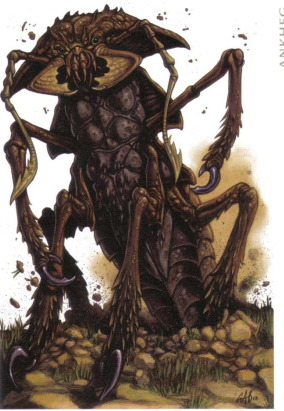Let's Read the 4e Monster Manual 2: Ankheg

This article is part of a series! Click here to see the other entries.
Ankhegs appear in AD&D 1st Edition, and they would go on to achieve minor fame among players because of their lore.
The Lore
Ankhegs are giant burrowing insects who dig mazelike tunnel networks and hunt by bursting through the ground and snatching surface prey with their huge mandibles. They also have acidic saliva, which they can spray at enemies.
These creatures live in “family units” consisting of a mated pair and a small brood of young. These broodlings are rarely seen on the surface - their parents bring prey to them underground. Other things might also be living in ankheg tunnels, since the creatures don’t use all of it as living space.
This is the extent of the lore we get in the MM2, but it was the bits left out that made ankhegs low-key famous. These bits say that ankhegs prefer to dig through soil rich in minerals and organic matter. This means forests, but it also means good farmland. Therefore, these creatures are likely to be found very close to civilized settlements. I think I saw at least one source that said having ankhegs underground actually improved the quality of the soil. If this isn’t true in your campaign, it might very well be a common folk superstition.
Even if ankhegs don’t enrich the soil, their presence might still act as an extra security measure against the many other dangers from the wild, assuming the farmers in question can develop some way of avoiding the beasts themselves. If you walk without rythm, you won’t attract the worm. Unfortunately, it looks like they cannot be tamed, so farming in ankheg country makes for a very interesting life. Fortunately, you won’t find more than one “family” of ankhegs in a given area.
The Numbers
Ankhegs are Natural Beasts, with the adults being Large and the broodlings Small. Both have tremorsense and a burrow speed, and are of animal intelligence.
Ankheg
This adult specimen is a Level 3 Elite Lurker with 100 HP. It has Resist 5 Acid to protect itself from its own saliva, a land speed of 8, and a burrowing speed of 4 with the Tunneling keyword, which means it leaves stable tunnels behind.
The classic ankheg tactic is for the beast to use its Stealth training and burrowing speed to lie in wait underground until it senses prey passing above. Then it’s going to erupt and hit its victims with an Acid Spray (close burst 3 vs. Reflex) which deals immediate and ongoing acid damage and also slows (save ends both). It can do that again it if’s bloodied.
Next it’s going to nab the nearest victim using a Mandible Grab, which damages and grabs (Acrobatics DC 16 or Athletics DC 14 to escape). It can only grab one victim at once, but Mandible Carry allows it to move normally with a grabbed victim. If the victim struggles too much the ankheg can also Gnaw and Scuttle as a minor action, which requires an attack roll and does physical damage and ongoing acid damage (save ends) in addition to allowing the monster to shift 2 squares.
The ankheg can put a lot of distance between itself and its victim’s buddies in a single turn by using a double move and spending a minor action on Gnaw and Scuttle. Still, if someone does manage to reach it while it has a grabbed victim, it can use claw attacks to fight in melee.
Ankheg Broodling
Ankheg attacks are fun for the whole family, because you’re going to be jumped by Mom and Dad, who will then carry you a ways underground so the kids can come out and eat.
Broodlings are Level 1 Minion Brutes, with the same tremorsense as the adults, a land speed of 6 and a burrow speed of 2 with Tunneling. They have basic claw attacks along with a less accurate and more damaging Mandible Rip that deals some “splash” acid damage to enemies adjacent to the target on a critical. Brood Swarm gives them a +4 bonus when attacking a creature grabbed by any ankheg. This more than negates the accuracy penalty from Mandible Rip.
Sample Encounters and Final Impressions
The sample encounter is Level 4: a pair of ankhegs and 6 broodlings plus a rage drake that was likely their original intended victim before the party came along.
My initial impression of anhkegs was that they were just another big bug monster, but the possibility of a setting where ankhegs under your farm fields are just another fact of life makes the more interesting in my eyes. The section on encounter groups also mentions that sometimes giant ants “take control” of a group of broodlings after they drive their parents away, and I can almost hear David Atenborough narrating that nature documentary.